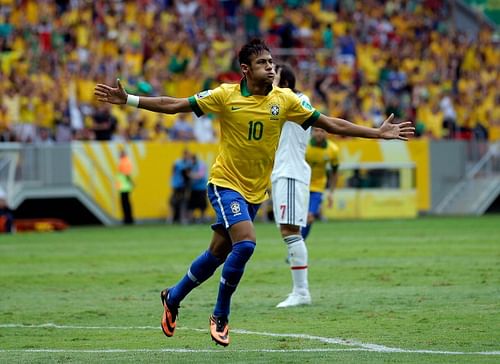
Neymar renews Brazil's number 10 love affair

As Neymar drove a blistering shot into the top-right corner of the Japanese goal in Brazil’s Confederations Cup opener on Saturday, he strengthened his claim to one of the most coveted garments in world sport.
There are many iconic shirt numbers in football — the Argentina number 10, the number seven shirt at Manchester United, Celtic and Liverpool — but none are as evocative as Brazil’s numero dez.
In many countries, such as Argentina, Italy and the Balkan states, the number 10 is associated with languid playmakers, but in Brazil it often graces the torso of the team’s most dynamic player.
When someone dons the shirt, they are thereby grasping a thread that runs all the way back to the great Pele.
Pele first wore the jersey as a 17-year-old at the 1958 World Cup in Sweden and it did not leave his back until he called time on his international career, 13 years and three World Cup winners’ medals later, in 1971.
As well as his 77 international goals, Pele’s outrageous inventiveness meant that the shirt came to represent Brazil’s innate gift for creativity.
At the 1970 World Cup, Brazil’s crowning glory, he tried to lob the Czech goalkeeper from halfway and later flummoxed Uruguay goalkeeper Ladislao Mazurkiewicz with an audacious dummy in the semi-finals.
Neither action resulted in a goal, but with his imagination and his ideas, Pele gave thrilling hints that there were new and unorthodox ways to play the game.
Any number of Brazil’s players could have sported the number 10 at the 1982 World Cup in Spain, but the honour fell to Zico, who spearheaded one of the most popular teams never to have won the tournament.
Pele aside, the only other men to lift the World Cup in the Brazil number 10 shirt are Rai and Rivaldo, both of whom possessed the requisite attributes of elegance, vision and match-changing class.
With its green numbering against a yellow background, the shirt is recognisable all around the world, but in the wrong circumstances, it can weigh like a lead weight.
Ronaldinho and Kaka, Ballon d’Or winners both, failed to inspire Brazil at the World Cups of 2006 and 2010, and recent wearers, including Neymar’s former Santos team-mate Ganso, have fared little better.
“The number 10 normally denotes two things,” says Brazilian football specialist and writer Jack Lang.
“Firstly, and most obviously, an element of fantasy: the 10 is the player who can win a match — or rescue it — with a feint, flick or free-kick.
“But the craque (star player) has a burden to bear: he’s not like the other players, so isn’t judged by the same criteria.
“There is a responsibility involved because the team’s prospects are so entwined with his performance.”
It was therefore with great care that Neymar was eased into the number 10 shirt.
For Santos, and at previous tournaments with Brazil, he has worn the number 11 shirt, synonymous with the skittish outside-lefts of yesteryear.
A number 11 can be a great talent, but he is rarely the player around which the team is constructed.
By asking for the number 10 shirt, Neymar gave a clear sign that he believes he is now ready to live up to the expectations that have awaited him ever since his fledgling steps for Santos as a prodigious 17-year-old.
He has played down the switch, insisting the number has “no importance”, but he will know, like any Brazilian, that it symbolises the heritage of the pastime by which the entire nation defines itself.
At Barcelona, where he will play from next season, the number 10 shirt already belongs to the world’s best player, Lionel Messi.
But in an emerging Brazil team in need of a leader, it is his for the taking.